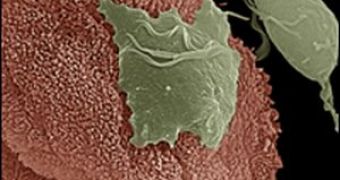You may have heard more about syphilis or HIV, as the most known sexually transmitted diseases.
Or maybe gonorrhoea and genital wart seem to you the most common ones.
Well, it's not like that: the most common genital pathogen is not a bacterium or virus, but a tiny monocell animal, named Trichomonas vaginalis: 170 million cases of trichomoniasis worldwide yearly, 8 million in US alone.
Trichomonas infection rises susceptibility to HIV infection (the wounds in the vagina are prone to be entering gates) and causes some women to have a frothy, stinky discharge. "You can tell it's growing well if you have a foul smell wafting out of the dish," said Jane Carlton, a genomist at New York University. "It's the most common nonviral sexually transmitted infection, bigger than chlamydia, syphilis or gonorrhea," she adds. "Yet, it's just ignored because some people are symptomless, especially males."
Researchers were taken by surprise discovering that trichomonas has 10 times more genetic material than its closest relatives, parasite on the gut, and more confirmed genes (26,000) than the human species do. Moreover, as its DNA analysis is partial, the gene number could go up to 34,000, this is the biggest genome of any single-celled organism yet analyzed.
Trichomonas genome is the most repetitive ever sequenced, 65 %, by far. "We don't currently have the computer algorithms for dealing with such a genome. It's still in thousands of pieces."
The repetitive genes enable the parasite to cause illness consuming other cells, from surrounding benign bacteria to the body's red and white blood cells from the blood. "It has more than 800 genes coding for surface proteins and that's a huge number to have," Carlton says.
Researchers suspect that the microbe added some of its neighbor genes along the way; at least one gene was proven to originate from a bacterium, allowing Trichomonas to make its own amino acid for the first time. The genome's size might have increased as Trichomonas passed from the gut to the genitals. Because Trichomonas eats good bacteria from vagina and urethra, it alters the overall acidity of the environment more to its liking. Scientists want to investigate Trichomonas species from cattle, to understand the emergence of this overgrown genome. "I'd like to sequence that and see if it's a similar size, which would be one way to prove our hypothesis," Carlton muses.
Photo credit: Antonio Pereira Neves, Santa Ursula University, Rio de Janeiro, Brazil

 14 DAY TRIAL //
14 DAY TRIAL //